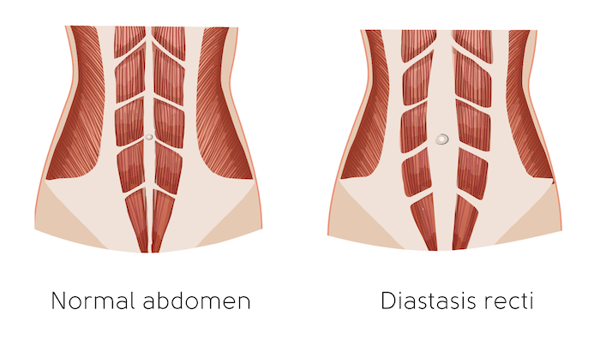Have you been noticing a bulge in your stomach since your pregnancy that isn’t going away? It could be diastasis recti.
During pregnancy, it’s common for the two muscles (rectus abdominis) that run down the middle of your tummy to separate, this is called diastasis recti. The muscles normally re-oppose themselves within 3-6 months postpartum; however, on the off chance they don’t — it can result in a series of functional and cosmetic issues.
Fortunately, the condition is treatable with professional care and assistance. The key is to recognise the situation promptly and intervene early once diagnosed. As if left untreated, diastasis recti could put patients at risk of back problems. So how does it happen, and how can you treat it?
What is diastasis recti?
Diastasis recti is the partial or complete separation of the rectus abdominis (i.e. the ‘six-pack’ muscles) at the midline of the tummy. This results in an area of weakness that allows the organs in the abdominal cavity (e.g. bowels) to bulge out. The condition is most commonly seen in women post-pregnancy, affecting over 30% of women 12 months postpartum.
How and why does diastasis recti happen?
During pregnancy, the uterus grows significantly in size. Towards the end of your pregnancy, it can extend all the way from the pelvis to below the ribcage. As the body accommodates the growth, this results in the skin stretching out and the rectus muscle splitting sideways.
After delivery, the uterus will shrink significantly and gradually return to its normal size — around the size of a small lemon. In most cases, the muscles will realign themselves. This process can take up to 6 months.
However, on the occasion that the muscles fail to re-oppose and remain split months after pregnancy, this is called diastasis recti. The condition is more likely to happen in women with multiple pregnancies, polyhydramnios (too much amniotic fluid during pregnancy), and women who’ve had large babies; as these conditions put extra pressure on the abdominal wall.
Symptoms of diastasis recti
The most common symptom is a vertical bulge along the midline of the abdomen. The rectus abdominis is our main anterior abdominal wall muscles and is an important part of our core muscles.
In patients with diastasis recti, a dysfunctional rectus abdominis can cause their core to destabilise, shifting the burden of support to our core in the lower back. This results in lower back pain, poor posture and can make individuals more prone to muscle injuries. Other symptoms that can occur are bloating, constipation and abdominal discomfort.

Self-testing for diastasis recti
To find out if you have diastasis recti, you can follow the steps below:
- Lie on your back with your legs bent and your feet flat on the floor.
- Raise your shoulders off the floor slightly and look down at your stomach.
- Use the tips of your fingers to feel the muscles above and below your belly button. See how many fingers you can fit into the gap between your muscles.
- If you can fit two or more fingers into the gap, you may have diastasis recti.
You’re recommended to do this regularly after pregnancy, and if the gap does not start to narrow down after a few weeks, then you need to consult a doctor.
Treating diastasis recti
Mild cases of diastasis recti can be improved through physiotherapy and exercises. But more severe cases may require surgical repair.
Treatment by exercises
Certain exercises can help improve diastasis recti. You could try to tighten your tummy by doing some strengthening and stretching exercises to help your deep core muscles.
However, it’s important to remember that some exercises may do more harm than good. Avoid any strenuous activity that can cause your abdominal wall to bulge out, or strains the midlines of your abdominals. Specifically, avoid sit-ups, crunches and heavy lifting as they tend to worsen diastasis recti. If you’re unsure about what exercises are suitable, consult with your doctor.
Treatment by surgery
If you’ve been exercising for a while and there is still no improvement, or if you have moderate to severe diastasis recti (e.g.if you can fit 4 fingers between the muscle gap) it may be time to consider surgery.
Diastasis recti surgery is similar to a tummy tuck. Generally, it involves surgically bringing the separated muscles back together. Women post-pregnancy also commonly have excess abdominal skin; the skin is often re-draped and tightened during surgery.
The surgery involves excising the lower part of excess skin (including, if any, the caesarean scar and stretch marks from pregnancy). The surgery is performed under general anaesthesia and takes around 2 to 4 hours. Most patients can go home in 3 to 4 days.
Proper post-operative care can boost recovery and lessen recovery time. After surgery, most patients can gradually resume exercises to regain core strength.
As with most other plastic and reconstructive surgeries, diastasis recti surgery involves risks. Some common risks are blood loss, anaesthesia problems, infection, and other complications. You can discuss these with your doctor at length before proceeding.
Help at OT&P
At OT&P, we believe in the importance of giving our patients' awareness and control over their health at every stage. Whether you are looking to optimise your physicality and mobility or have been affected by injury, our physiotherapists at BodyWorX clinic will be able to tailor a solution for you. Book an appointment or call our registration desk to find out more.

 Central General Practice
Central General Practice
 Repulse Bay
Repulse Bay
 Clearwater Bay
Clearwater Bay
 BodyWorX Clinic
BodyWorX Clinic
 Central Specialist Clinic
Central Specialist Clinic
 MindWorX Clinic
MindWorX Clinic
 Partner Clinics
Partner Clinics
 Family Clinic
Family Clinic
 OT&P Annerly Midwifes Clinic
OT&P Annerly Midwifes Clinic

